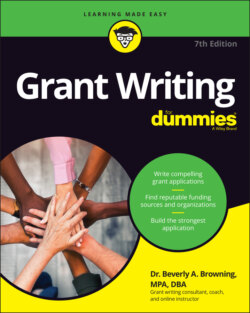Читать книгу Grant Writing For Dummies - Stan Hutton, Beverly A. Browning - Страница 63
Making Sure You Have the Mandatory Attachments Before You Start Writing
ОглавлениеVirtually all grant applications require a few standard attachments that provide additional information about the grant applicant organization. These attachments follow the grant or cooperative agreement narrative. The following list outlines some of the things you’ll likely attach to your grant request. Keep in mind that each funder has its own instructions on how to order these attachments, so the order here isn’t necessarily standard.
Funders are often very specific with regard to attachments. Many accept only the attachments they specifically list. If the funding source’s guidelines indicate that the funder accepts no attachments or that submitting any material besides the grant application results in the application not being reviewed, omit the standard attachments covered in this list:
Budget summary/cost summary: Fill in the blanks on a standard worksheet listing line items and expense amounts as required by the grant guidelines or directions. (Head to Chapter 18 for more about budgets and financial stuff.)
Budget detail/budget narrative/cost justification: Write a detailed narrative on each proposed expense.
Up-to-date financial statement: Attach a copy of the grant applicant organization’s most recent financial statement. Whether audited or unaudited, the financial statement should explain any findings of concern.
Proof of tax-exempt status (if applicable): Proof is a copy of the grant applicant organization’s 501(c)(3) letter of nonprofit determination from the IRS, with the date on which a certifying agency recognized the status.
Board of directors with affiliations: This attachment lists the names and board positions of the organization’s governing body along with their position within the community (board of directors, city council members, village trustees, and so on). This document also should mention the lengths of their board terms and amount of time remaining to be served.
Letters of commitment: A letter of commitment comes from a partner organization and states that the partner is committed to providing leveraging assets to your grant-funded program when funded. Partner organizations can commit to providing cash, facilities, technical assistance, equipment, supplies and materials, or loaned staff. Ask for letters of commitment from affiliates early in the writing process, and include at least three such letters with all grant applications you send out.
Memorandum of Agreement (MOA) and Memorandum of Understanding (MOU): The names for these requested documents can be interchangeable depending on the type of funding agency. Typically, they’re multipage formal contracts between the grant applicant and its program implementation partners. These documents detail the role of each party in the agreement and include their specific committed tasks when the funding is awarded.
Annual report: Include an annual report (brochure, booklet, or newsletter).
Other documentation: Submit one-page summaries or complete résumés of key program personnel, as the funding source prefers. Also, if your organization has Memoranda of Agreement or Memoranda of Understanding signed by partner or collaborating agencies, attach these documents last. (Go to Chapter 10 for more information on these documents.)
